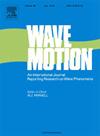Ultrasonic field estimation for random P -and S-wavenumbers in isotropic solids using DPSM
IF 2.5
3区 物理与天体物理
Q2 ACOUSTICS
引用次数: 0
Abstract
The measurement of elastic constants often shows randomness, which consequently affects the propagation of P- and S-waves in a solid material. In the theory of wave propagation, longitudinal and transverse waves are characterised using P-and-S wavenumbers ( and ), which can be modelled as a random variable to simulate random ultrasonic fields. In this research work, an efficient and accurate solution technique to model random wave propagation due to random wavenumbers using Distributed point source method (DPSM) is developed. DPSM is a semi-analytical method that requires Green’s function (GF) solution for producing ultrasonic fields in homogeneous or heterogeneous solids and near the fluid-solid interface. The generation of ultrasonic fields at higher frequencies and in complex structures requires a large number of distributed point sources, thereby leading to the computation of a greater number of GFs. Therefore, the numerical calculation of random wavefields increases the computational complexity. An analytical model to approximate first-order and second-order moments of the displacement GF solutions for isotropic solid corresponding to randomly distributed P- and S-wavenumbers is proposed. The statistical moments (mean and variance) of ultrasonic fields (stresses and displacement fields) near the fluid-solid interface and in the solid half-space are calculated using the proposed theoretical model. The efficacy and accuracy of the proposed model for normally distributed wavenumbers are illustrated through two numerical analyses. Initially, the mean ultrasonic fields such as displacement and stress fields are evaluated using both the proposed analytical model and Monte Carlo (MC) simulation for 1 MHz excitation frequency. Mean and standard deviations of the total scattered wavefields are computed near the interface and along the solid medium. Further, to check the robustness of the proposed analytical model ultrasonic fields for 2.25 MHz excitation frequency are computed for the same problem configuration and the mean fields are compared with the MC simulation. The computed mean displacement GF solutions and ultrasonic fields using the proposed model for normally distributed wavenumbers match precisely with the MC simulation. Further, the standard deviation of the ultrasonic fields for normally distributed wavenumbers is estimated for different transducer frequencies.
用DPSM估计各向同性固体中随机P波数和s波数的超声场
弹性常数的测量往往表现出随机性,从而影响了纵波和横波在固体材料中的传播。在波传播理论中,纵波和横波用p波数和s波数(kp和ks)来表征,p波数和s波数可以建模为随机变量来模拟随机超声场。在本研究中,提出了一种利用分布式点源法(DPSM)求解随机波数引起的随机波传播的高效、准确的方法。DPSM是一种半解析方法,需要格林函数(GF)解来产生均匀或非均匀固体和流固界面附近的超声场。在高频率和复杂结构中产生超声场需要大量的分布点源,从而导致计算更多的GFs。因此,随机波场的数值计算增加了计算复杂度。提出了各向同性固体随机分布P波数和s波数对应的位移GF解的一阶和二阶矩近似解析模型。利用所提出的理论模型计算了流固界面附近和固体半空间内超声场(应力场和位移场)的统计矩(均值和方差)。通过两个数值分析说明了该模型对正态分布波数的有效性和准确性。首先,利用所提出的解析模型和蒙特卡罗(MC)仿真计算了1 MHz激励频率下的平均超声场,如位移场和应力场。计算了界面附近和沿固体介质的总散射波场的均值和标准差。进一步,为了验证所提解析模型的鲁棒性,对相同问题配置计算了2.25 MHz激励频率下的超声场,并将平均场与MC仿真进行了比较。采用正态分布波数模型计算的平均位移GF解和超声场与MC模拟结果吻合较好。此外,估计了不同换能器频率下正态分布波数的超声场的标准偏差。
本文章由计算机程序翻译,如有差异,请以英文原文为准。
求助全文
约1分钟内获得全文
求助全文
来源期刊

Wave Motion
物理-力学
CiteScore
4.10
自引率
8.30%
发文量
118
审稿时长
3 months
期刊介绍:
Wave Motion is devoted to the cross fertilization of ideas, and to stimulating interaction between workers in various research areas in which wave propagation phenomena play a dominant role. The description and analysis of wave propagation phenomena provides a unifying thread connecting diverse areas of engineering and the physical sciences such as acoustics, optics, geophysics, seismology, electromagnetic theory, solid and fluid mechanics.
The journal publishes papers on analytical, numerical and experimental methods. Papers that address fundamentally new topics in wave phenomena or develop wave propagation methods for solving direct and inverse problems are of interest to the journal.
 求助内容:
求助内容: 应助结果提醒方式:
应助结果提醒方式:


